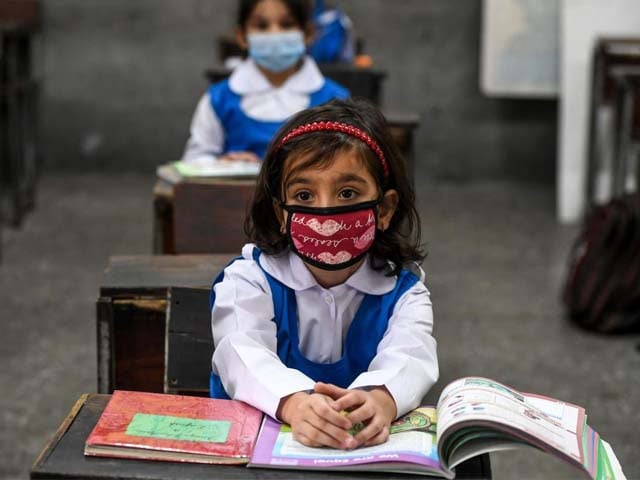
Like the broken tax system, rising inflation, unemployment, frequent episodes of violence, and debilitating health infrastructure, another major sphere of economy and public life where Pakistan’s government has successfully managed to underperform is its education system. The education crisis is such that it is no less than a state of education emergency.
National and international media and experts have been reiterating what has emerged as two stylised facts about Pakistan’s education system. One, 26 million children are out of school (which is a humongous share of 39 percent of Pakistani children[1]); two, 43 million children in school are not learning as much as they should. Thus, the education system is suffering badly on the fronts of enrolment and learning outcomes due to learning poverty[2] and “decades of deliberate underinvestment and disregard[3]”
One major culprit is the lack of social provisioning of education in Pakistan. First, the education budget has been shrinking. In 2022, the Pak government spent only 1.9 percent of its GDP on education compared to 2.65 percent in 2015, lying behind other South Asian and sub-Saharan countries, despite being well-versed with the fact that its 26.2 million children are out of school[4][5]. Second, the lack of investment in the public provisioning of education has paved the way for the privatization of education at a massive pace, making education again accessible only to the rich. Moreover, the quality of the private schools that are springing up in every nook-and-corner of Pakistan is sup-optimal due to untrained, overworked, and underpaid teachers. Substandard learning environments and resources would lead to substandard learning outcomes: there is no rocket science here.
Third, and more interestingly, experts opine that it is not the budget that is the problem but how the budget is spent on education. The education system suffers from severe misspending, which can’t be addressed without reforming the education system. Any increase in the education budget is subjected to leakages through crony capitalism and corruption, making it futile. The problem lies with commission-based construction work contracts of schools, which provide fertile ground for corruption. Moreover, teacher absenteeism and teachers-politicians’ linkages, where political parties are involved in the recruitment of teachers, are rampant across Pakistan. There is a clear patronage politics in which teachers act as political workers for the political parties in return for their recruitment[6].
The regional disparities are well reflected in access to education as well. Baluchistan, with all its underdevelopment and instability, has 65 percent of its children out of school[7]. Moreover, a majority of the 26.2 million children are concentrated in rural areas, and 58 percent of them happened to be females[8].
If about 39 percent of Pakistani children are not able to access education, it implies a generation of people without basic education to get employment, left to be exploited and subjected to poverty. The impact of a difunctional education system is large and prolonged, given that education has larger marginal social benefits (and thereby resulting losses if not corrected). Without sufficient education, youth in Pakistan are not fit to be inducted into the labor market, making them susceptible to placements in militant organizations. This is a larger social loss to society, where the uneducated (or, if at all, poorly educated) youth become a part of social disharmony and a threat to society.
Pakistan also needs to tackle its economic crisis to curb its education crisis. Last year, in May, textbook prices had increased by an alarming 95 percent making education not just inaccessible but also unaffordable for many due to crushing inflation. People in the lowest quintiles of income across provinces are mostly susceptible to be out-of-school, and in case they get enrolled, they face a higher probability of dropping out, with females bearing the major brunt. Access to education is becoming more inequitable, with rising privatization (making quality education accessible only to the rich) and the poor dropping out and succumbing to the worsening economic conditions.
The system requires swift and multi-dimensional reforms across its length and breadth. Increasing the number of schools, reforming the examination system, which heavily depends on rote learning, reforming curriculum, and better enforcement so that the problem of ghost teachers is eliminated[9]. Moreover, clientelism in teacher recruitment and corruption in commissioning constructions and reparations need to be corrected by making it a more accountable, transparent, and robust monitored system.
There is a need to address both the demand and supply side challenges to the education system, including accessibility and affordability of education, education infrastructure, and regional and gender disparities. As per World Bank experts[10], learning poverty[11] in Pakistan can be eliminated by focusing on policies tailored to the needs of diverse groups of out-of-school children. This implies that teenage children who have never been to school need to be provided with special assistance instead of being sent to regular schools. Besides, there is a dire need to enhance efficiency and target public expenditure where education outcomes are the poorest. Given the condition of education, children not only need to be brought to school, but they also need to be provided with a congenial learning environment to bridge the learning gaps. However, given the sheer lack of commitment to the reforms and lip service in the name of calling out the rhetoric of a “nationwide education emergency,” it is pertinent to see if the ruling elite would take massive actions to ameliorate the ailing education system and the masses.
[1] https://www.dawn.com/news/1808713
[2] https://www.dawn.com/news/1777986
[3] https://tribune.com.pk/article/97833/pakistans-education-crisis-moving-from-rhetoric-to-action#:~:text=The%20scale%20of%20the%20problem,teacher%20training%20and%20governance%20structures.
[4] https://data.worldbank.org/indicator/SE.XPD.TOTL.GD.ZS?locations=PK
[5] https://timesofindia.indiatimes.com/education/news/education-crisis-deepens-26-21-million-children-out-of-school-in-pakistan-reveals-pie-report/articleshow/107040077.cms#:~:text=Despite%20a%20decrease%20in%20the,million%20during%20the%20same%20period.
[6]https://www.wilsoncenter.org/sites/default/files/media/documents/publication/pakistanseducationcrisistherealstory2.pdf
[7] https://timesofindia.indiatimes.com/education/news/education-crisis-deepens-26-21-million-children-out-of-school-in-pakistan-reveals-pie-report/articleshow/107040077.cms
[8] https://www.brecorder.com/news/40298670
[9] https://tribune.com.pk/article/97833/pakistans-education-crisis-moving-from-rhetoric-to-action
[10] https://blogs.worldbank.org/en/endpovertyinsouthasia/pakistan-quality-education-requires-different-approach-and-more-investment
[11] https://www.worldbank.org/en/topic/education/brief/what-is-learning-poverty#:~:text=Learning%20poverty%20means%20being%20unable,simple%20text%20by%20age%2010.







